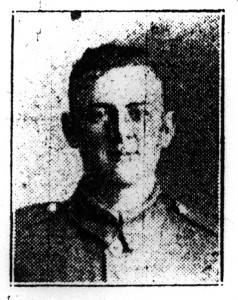Frank Lloyd
Private 28670
1st Battalion Kings Shropshire Light Infantry
(formerly 8/11985 Devon Regiment)
It was not until the closing stages of writing the book “The School, the Master, the Boys and the V.C.” that evidence was found to suggest the identity of this soldier. The CWGC web site revealed many F. Lloyds but all lacked family details that would link them to Reading. However, some research carried out on the War Memorial tablet of St. Peter’s Church, Earley, revealed the name Frank Lloyd. Using the Soldiers Died in the Great War a Frank Lloyd, born in Basingstoke and enlisted in Reading was revealed.
More recently, in 2014, with access to Ancestry UK, it has been possible to obtain more information. Frank Lloyd was born 19 December 1899, the son of Frank and Harriet Lloyd. In 1901 the family lived at 24 Sun Street, Reading. Frank senior was a labourer at the biscuit factory. Frank had two sisters Leila aged 2, and Florence Moth, his stepsister aged 8. By 1911 the family had moved to Swansea Road. Frank now had two younger brothers Edgar and George and Florence was no longer living at home. Frank senior was now a labourer in a timber yard. No occupation was given for any of the children so it is assumed that both Leila and Frank at 12 and 11 years were still in school.
Ancestry UK also has military records for Frank Lloyd but although they are with entries for Frank Lloyd junior they are in fact his fathers pension records. Frank senior, attested 28 July 1915 aged 34 as a member of the Royal Berkshire Regiment. The family were then living at 59. Brighton Road. He was discharged as no longer fit for war service on 9 November 1917, he held the rank of sergeant. His papers reveal that daughter Leila was a cripple. Frank’s military conduct and character were described as very good.
It is not known when the family moved to Brighton Road but this would certainly have enabled Frank junior to attend the Wokingham Road School and for the family to have worshiped at St. Peter’s Church, Earley.
Frank Lloyd junior was killed in action on 17th October 1918 on the day when the British and American forces began a massive attack along the River Selle north of Le Cateau. A CWGC search indicated that he was buried in the small Vaux-Andingy British Cemetery, Aisne, which holds sixty graves. The village, which lies between St. Quentin and Le Cateau, was captured in the attack. Originally the cemetery had also held German graves but these were later removed and thirty-five graves from the communal cemetery re-interred there after the Armistice. Frank Lloyd’s grave is located in Row C. 8
